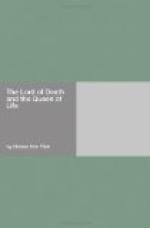At first it was hard to see; then, little by little, there unfolded before their eyes a giant, spiderlike system of chasms in the strange surface beneath them. From a point almost directly opposite the sun, these cracks radiated in a half-dozen different directions; vast, irregular clefts, they ran through mountain and plain alike. In places they must have been hundreds of miles wide, while there was no guessing as to their depth. For all that the four in the cube could see, they were bottomless.
“Small likelihood of anybody being alive there now,” commented the geologist skeptically. “If the sun has dried it out enough to produce faults like that, how could animal life exist?”
“Notice, however,” prompted the doctor, “that the cracks do not extend all the way to the edge of the disk.” This was true; all the great chasms ended far short of the “twilight band” which the doctor had declared might still contain life.
But as the sky-car rushed downward their attention became fixed upon the surface directly beneath them, a point whose latitude corresponded roughly with that of New York on the Earth. It was a region of low-lying mountains, decidedly different from various precipitous ranges to be seen to the north and east. On the west, or left-hand side of this district, a comparatively level stretch, with an occasional peak or two projecting, suggested the ancient bed of an ocean.
By this time they were within a thousand miles. Smith threw on a little more current; their speed diminished to a safer point, and they scanned the approaching surface with the greatest of care. The architect, who was a New Yorker, was strongly reminded of the fall aspect of the Appalachians; but Van Emmon, who was born and raised on the Pacific coast, declared that the spot was almost exactly like the region north of San Francisco. “If I didn’t know where I was,” he declared, “I’d be trying to locate Eureka right now.”
The engineer smiled tolerantly. He had spent several years in Scotland, and he felt sure, he obligingly told the others, that this new locality was far more like the Ben Lomond country than any other spot on earth. He was so positive, he made the doctor, a New Zealander, smile quite broadly.
“It is just like the hills near my home,” he stated, with an air of finality which made further discussion useless.
“There’s a river!” the architect suddenly exclaimed, pointing; then added, before the others could comment, “I mean, what was once a river.” They saw that he was right; an irregular but well-defined streak of sandy hue trickled down the middle of their chosen destination—a long, L-shaped valley, surrounded by low hills.
“That’s the most likely place, outside of the twilight zone, for life to be found,” remarked the doctor. “Neither mountainous nor dead level.”
He added: “The spectroscope has plainly shown that there’s water vapor in what little air there is. Must be precious little. If the air was as humid as the earth’s, we couldn’t see the surface at all from this height.”




